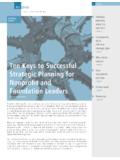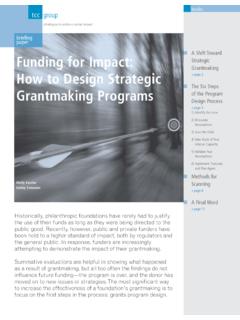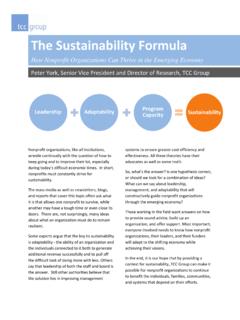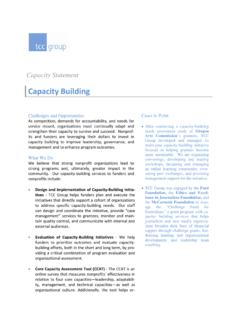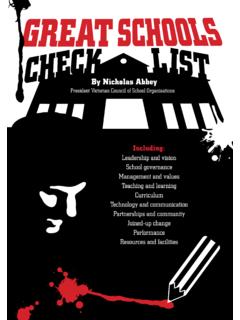Transcription of page 3 Effective Nonprofit Evaluation: Through a - TCC Group
1 INSIDEIn recent years, internal evaluation has become increasingly useful, both for Nonprofit organizations and for funders. For funders, such mechanismshave been useful to measure the success of their funding strategies. For non-profits, they have been used both to satisfy the increasing external demandfor accountability and to more accurately measure their impacts and nonprofits that have utilized evaluation most successfully are those that have embraced them by fully integrating them into their programs and operations, involving staff, stakeholders, and board members to produce continuous internal improvements that build on prior successes and increase and Organize theDecision Makerspage 3 DetermineRoles and Responsibilities in the Evaluationpage 5 evaluation Design and Implementationpage 7 Utilizing evaluation Resultspage 10 Girl s BestFriend Foundation: A Case Studypage 8 Chantell Johnson and Allison CreanEffective Nonprofit evaluation .
2 Through a Community of Learners briefingpaper2briefing paperThis is best accomplished by creating what TCCG roup terms a Community of Learners (CoL). At its simplest, CoL moves beyond the traditional hierarchical evaluation to include all those whohave knowledge about the successes (and failures)of a Nonprofit s programs. These individuals becomeknowledgeable about evaluation , skilled in its design and implementation, and actively engagedin its dissemination. In this sense, the Communityof Learners not only supports evaluation , but alsoencourages a shift in the organization s culture toward evaluative CoL approach usesevaluation as a tool for realizing the organization sgoals while simultaneously building a culture forcontinuous that engage in a CoL process are motivated by the strong benefits (as outlined in Figure 1), including the advantages of owning theevaluation; the credibility associated with utilizingan external expert; the accumulation of cost- Effective , timely data aligned with needs; and, ultimately, the sustainability of the process.
3 Al-though CoL requires a willingness and commitmentof time on the part of a larger Group to participate,the potential gains outweigh the cost and effort involved, so few nonprofits find it paper defines CoL and provides a step-by-stepguide showing how TCC can create and develop acommunity of learners for evaluative learning and decision making across a wide range of nonprofits. In the discussion below, we contrastTCC s CoL approach with a more traditional modelof evaluation to further illustrate CoL s unique qualities, showing why this approach is becomingincreasingly popular among clients, nonprofits, and Process in BriefIn the traditional evaluation process, there are usually seven major steps: Step 1:Identify and organize decision 2:Determine who will conduct, participate in, and be the audiencefor 3:Develop a Logic 4: State the evaluation questions andindicators ( evaluation Framework).
4 Step 5:Develop evaluation methods, tools,and tasks ( evaluation Workplan).Step 6: Gather, analyze, and interpret 7:Utilize the evaluation uses the same process. The key difference lies in the extent to which a CoL approach organizesand involves employees, stakeholders, and , Steps 1 and 2 are usually the most critical in determining whether a Nonprofit s evalu-ation process will proceed along traditional lines, orwill progress down a more Effective CoL path. In a CoL process, individual stakeholders of the organization initially determine who will drive theCoL formation and the scope of the evaluation . Typically, the CoL begins with a core Group of the organization s stakeholders and staff, often anchoredby leaders in key positions focused on the questionof evaluation or organizational learning.
5 Over time,the scope of the Group broadens to include additional stakeholders, clients, and employees, andthe actions associated with the CoL evolve into theorganization s standard operating procedure. Strengths Perception of credibility Perception regarding rigor Perception of credibility Capacity in data collection,rigor Ownership of evaluation Data aligned with needs Timely data Cost Effective buying expertise SustainableLimitations Lack of capacity in evaluation , data use Data not aligned with needs Time delay in getting data Costly Requires willingness Requires participation Perception that planning time is longerTraditional EvaluationCoL EvaluationFigure 1: CoL versus Traditional Evaluation1 For an in-depth treatment of evaluative learning, see York, (2003).
6 Learning as weGo: Making evaluation Work for Everyone.(New York: TCC Group ). 2In fact, evaluation capacity building (ECB) has been a major topic at recent AmericanEvaluation Association conferences; TCC Group is a leader in both employing and developing this paper3 Essential to the success of the Community of Learners approach is the concept of evaluativelearning. This describes what an evaluation processshould ideally be: ongoing, collaborative, stake-holder-led, and informative to the organization. TheCoL approach enables evaluative learning to beachieved, encouraging those involved in evaluationsto learn key skills, thereby giving them a head starton the evaluation process and a more sophisticatedrole throughout the process. Successful CoL effortsincorporate evaluative learning into the regular ongoing programs of a Nonprofit .
7 Often, though not always, an outside facilitator, such as TCC, mayassist. TCC Group s original CoL concept paper, Creating a Community of Learners: Successful EvaluativeLearning for Nonprofits and Funders, outlined thebasic concept of CoL while this paper examines howa specific Nonprofit (the Archdiocese of Chicago sOffice of Catholic Schools) and a funder (the Girl s Best Friend Foundation) effectively used theCoL approach to build evaluation capacity and engage in (The full version of this caseexample is featured on page 8-9.)The Girl s Best Friend Foundation (GBF), a Chicago-based, private, grantmaking foundation funds grass-roots, community-based programs promotingleadership, activism, and social change by girls andyoung women. From its inception, GBF supportedthe Community of Learners approach, both for itself and for its grantors.
8 Over 13 years, CoL philosophy and practice has proven to increase mission fulfillment among GBF s grantors and amplify their impact over the long engaged in a CoL approach, the Archdioceseof Chicago s Office of Catholic Schools (OCS) maintains 256 schools within the diverse bound-aries of the Chicago area, serving 96,197 studentsfrom pre-kindergarten to twelfth grade. In additionto sharing the educational, accountability, and fiscalchallenges of public schools, OCS has a unique mission of instilling a sense of Catholic identity in its students. OCS s strategic management process,aptly called Genesis, focuses on missions of academic excellence, Catholic identity, and schoolvitality and is evidence-based and collaborative innature. When approaching its evaluation process,OCS desired to continue this collective approachand deemed TCC Group s CoL evaluation process as well-matched with its strategic planning and implementation illustrate the CoL process more fully, we haveused examples from OCS s successful have also outlined the traditional model of evaluation in order to compare and contrast it withthe CoL process, using information from the OCScase, as well as other clients, to illustrate what hasworked and what has been will beshown that the CoL approach, which has proven socompelling to OCS and other clients, can be utilizedby other funders and nonprofits with very diverseevaluation 1.
9 Identify and Organizethe Decision MakersSuccessful execution of Step 1 whether in a traditional or a CoL evaluation is crucial: Thosewho have the power to make decisions as the evaluation is designed, implemented, and unfoldsmust be clearly identified. But it takes on even more importance in a CoL process because a communityof learners will determine the nature, quality, andfunction of each of the remaining steps in the an evaluation Leadership TeamMay Not be theFirst StepOn occasion, it may not always be most efficacious toimmediately form a leadershipteam. For example, TCCG roup, when beginning workwith one organization (Actionfor Healthy Kids) determinedthat the organization was in a state of transition and flux,and that formation of an evaluation leadership teamwas not feasible or desirableat that point.
10 Nevertheless,TCC Group was able to workinformally, one-on-one with afew engaged leaders and staffto collect data and initiate adhoc evaluation planning for ayear before a formal leader-ship team was established tofurther the evaluation workand integrate evaluation intothe organization s life. SarahTitzer, Director of Programs forAction for Healthy Kids states: If not for our work with TCC,we would not have had thecapacity to ask the questionswe are asking now nor be in a position to demand the formation and function of anevaluation team to supportour work. 3 The Girl s Best Friend Foundation is not a client of TCC and engaged in this work independently of TCC. It should also be noted that the Community of Learners model worked well for the Girl s Best Friend Foundation both with and without the facilitation of an independent consultant.
